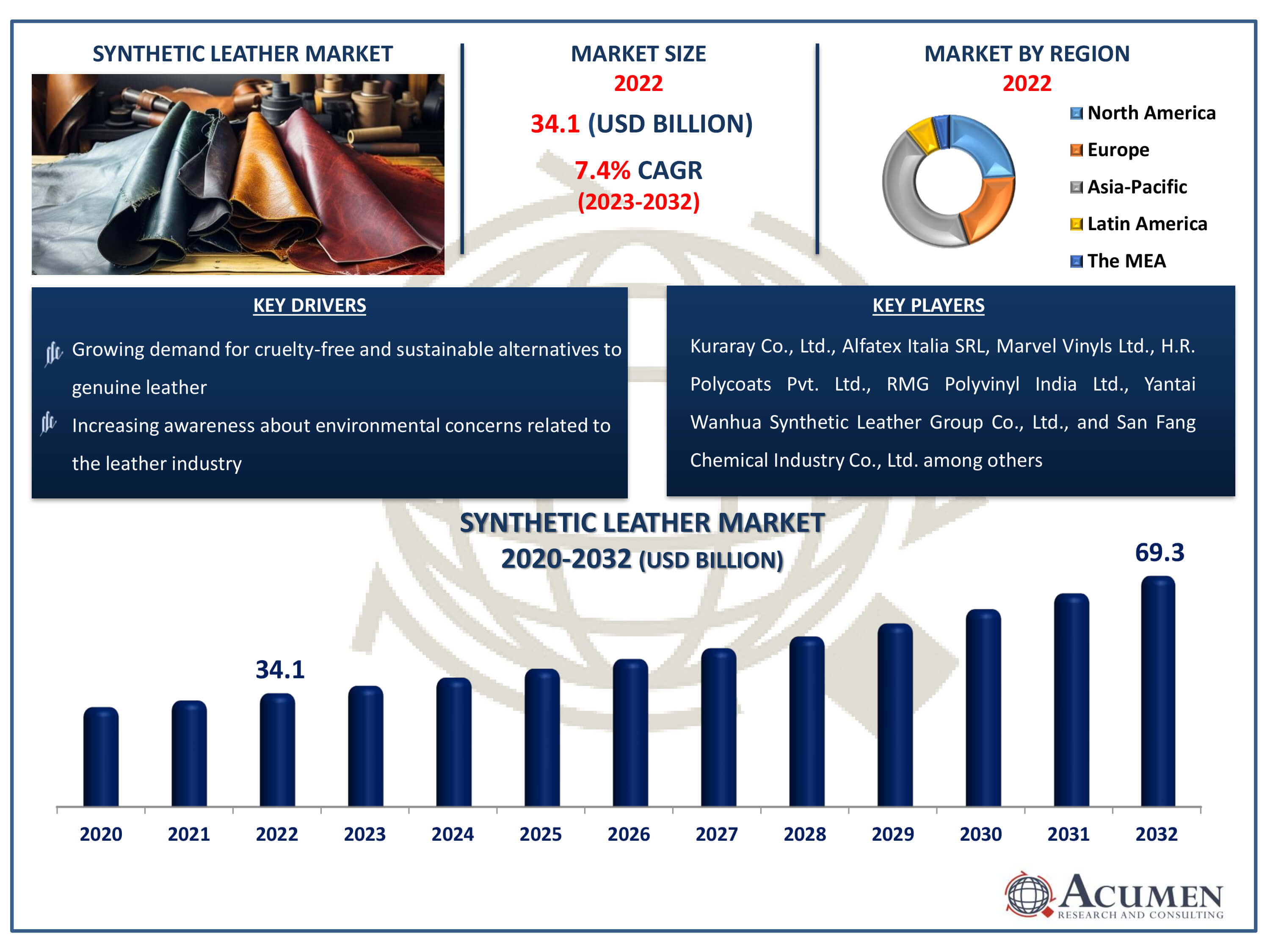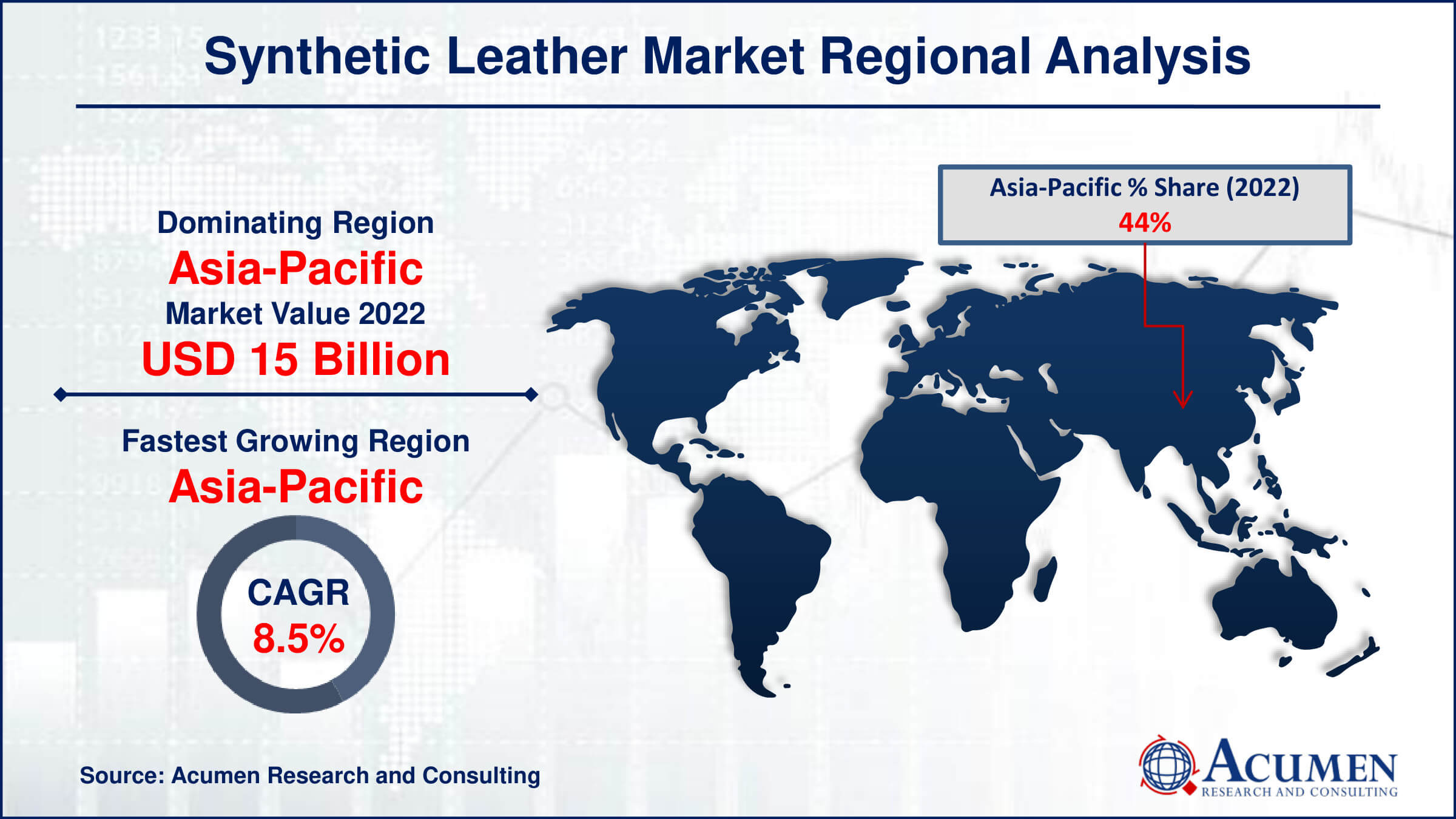Synthetic Leather Market | Acumen Research and Consulting
Synthetic Leather Market Size - Global Industry, Share, Analysis, Trends and Forecast 2023 - 2032
Published :
Report ID:
Pages :
Format :
The Synthetic Leather Market Size accounted for USD 34.1 Billion in 2022 and is estimated to achieve a market size of USD 69.3 Billion by 2032 growing at a CAGR of 7.4% from 2023 to 2032.
Synthetic Leather Market Highlights
- Global synthetic leather market revenue is poised to garner USD 69.3 billion by 2032 with a CAGR of 7.4% from 2023 to 2032
- Asia-Pacific synthetic leather market value occupied around USD 15 billion in 2022
- Asia-Pacific synthetic leather market growth will record a CAGR of more than 8.5% from 2023 to 2032
- Among product, the PU sub-segment generated around USD 20.5 billion revenue in 2022
- Based on application, the footwear sub-segment generated more than 33% market share in 2022
- Development of bio-based and sustainable alternatives to traditional synthetic leather materials is a popular synthetic leather market trend that fuels the industry demand

The synthetic leather market refers to the industry that produces, distributes, and uses fake leather products. Synthetic leather, often known as faux leather or leatherette, is made by combining polymers like polyvinyl chloride (PVC) and polyurethane (PU) to simulate the appearance and texture of genuine leather. It is widely used in upholstery, apparel, footwear, vehicle interiors, and other applications that require the visual appeal of leather without the usage of animal skins. The synthetic leather industry has grown significantly due to its adaptability, durability, and cost-effectiveness when compared to genuine leather, making it a preferred choice in a variety of sectors throughout the world.
Global Synthetic Leather Market Dynamics
Market Drivers
- Growing demand for cruelty-free and sustainable alternatives to genuine leather
- Increasing awareness about environmental concerns related to the leather industry
- Technological advancements leading to improved quality and performance of synthetic leather
- Rising adoption of synthetic leather in automotive and furniture industries for cost-efficiency
Market Restraints
- Volatility in prices of raw materials used in synthetic leather production
- Concerns regarding the biodegradability and environmental impact of synthetic leather
- Competition from other alternative materials such as natural fabrics and textiles
Market Opportunities
- Expanding applications of synthetic leather in the fashion and apparel industry
- Emerging markets in Asia-Pacific region offering growth opportunities for synthetic leather manufacturers
- Increasing focus on customization and personalization in synthetic leather products
Synthetic Leather Market Report Coverage
| Market | Synthetic Leather Market |
| Synthetic Leather Market Size 2022 | USD 34.1 Billion |
| Synthetic Leather Market Forecast 2032 |
USD 69.3 Billion |
| Synthetic Leather Market CAGR During 2023 - 2032 | 7.4% |
| Synthetic Leather Market Analysis Period | 2020 - 2032 |
| Synthetic Leather Market Base Year |
2022 |
| Synthetic Leather Market Forecast Data | 2023 - 2032 |
| Segments Covered | By Product, By Application, And By Geography |
| Regional Scope | North America, Europe, Asia Pacific, Latin America, and Middle East & Africa |
| Key Companies Profiled | Kuraray Co., Ltd., Alfatex Italia SRL, Marvel Vinyls Ltd., H.R. Polycoats Pvt. Ltd., RMG Polyvinyl India Ltd., Daman Textiles, Yantai Wanhua Synthetic Leather Group Co., Ltd., San Fang Chemical Industry Co., Ltd., Premier Polyfilm Ltd., Response Fabrics Pvt. Ltd., Mayur Uniquoters Ltd., and Giriraj Coated Fab Pvt. Ltd. |
| Report Coverage |
Market Trends, Drivers, Restraints, Competitive Analysis, Player Profiling, Covid-19 Analysis, Regulation Analysis |
Synthetic Leather Market Insights
The global demand prognosis has shifted as a result of increased uses in the furnishings, automobile, clothes, luggage, and other industries. As a result, firms are concentrating on increasing their production capacity. The worldwide market is fragmented and dominated by a handful of enterprises. This has resulted in high entry barriers, since these firms prioritise forward and backward integration across the value chain to improve efficiency and overall productivity. Rising regional markets, including China, India, Brazil, Malaysia, Thailand, and Vietnam, are likely to have a substantial impact on product demand. The widespread usage of synthetic leather in the footwear industry in these and other regional markets is likely to contribute to growth over the synthetic leather industry forecast period.
The development of bio-based and sustainable alternatives to traditional synthetic leather goods has commercial promise. With growing environmental concerns and client preferences for eco-friendly products, there is a larger need for synthetic leather made from renewable and biodegradable materials. Companies that do research and innovation to develop bio-based polymers derived from sources such as plant-based materials or recycled plastics can capitalise on this opportunity. Manufacturers may fulfil rising demand from environmentally conscious consumers and differentiate themselves in the market by providing sustainable synthetic leather alternatives.
Synthetic Leather Market Segmentation
The worldwide market for synthetic leather is split based on product, application, and geography.
Synthetic Leather Products
- PU
- PVC
- Bio based
According to synthetic leather industry analysis, polyurethane (PU) has been experiencing promising development in terms of product quality, variety, and yield. It is the largest product segment and is also expected to witness the fastest growth during the forecast years. Polyurethane is waterproof, softer, and lighter than genuine leather, can be washed and torn more easily than genuine hides, and remains unaffected by sunlight.
It is an eco-friendly substitute for vinyl-based products as it does not produce dioxins. All these factors are expected to further increase its demand. The PVC product segment is expected to see moderate growth over the synthetic leather market forecast period. PVC was the first type of synthetic leather made in 1920. Initially produced with carcinogenic chemicals, it proved to be an ideal material for applications in household products and furnishings.
PVC faced significant competition from PU as PVC provided a sticky feel and was unable to retain body heat. Consequently, its demand decreased in the apparel and bags application segment. Bio-based products are composed of polyester polyol and have 70-75% renewable content. They are softer and have better scratch resistance properties than PU and PVC.
Synthetic Leather Applications
- Furnishing
- Automotive
- Footwear
- Bags & Wallets
- Clothing
- Others
The footwear category dominates the synthetic leather market due to a number of compelling considerations. Synthetic leather, due to its adaptability and cost-effectiveness, has become a popular choice among footwear makers worldwide. One significant advantage is its ability to replicate the appearance and texture of genuine leather while also providing extra features such as waterproofing, durability, and simplicity of care. Footwear makers are increasingly turning to synthetic leather as a sustainable alternative to genuine leather, in line with customer desires for cruelty-free and eco-friendly materials. Furthermore, synthetic leather provides greater design versatility, allowing for the development of unique designs and patterns to cater to a wide range of consumer preferences.
Synthetic leather's performance features, such as its lightweight nature, resistance to abrasion, and ability to retain shape over time, make it ideal for footwear applications. Furthermore, advances in manufacturing procedures have resulted in higher quality and consistency of synthetic leather products, accelerating their adoption in the footwear sector. As worldwide demand for elegant yet inexpensive footwear rises, the footwear section of the synthetic leather market is predicted to increase steadily. Manufacturers and retailers are harnessing the benefits of synthetic leather to satisfy demand while also addressing ecological and animal welfare issues.
Synthetic Leather Market Regional Outlook
North America
- U.S.
- Canada
Europe
- U.K.
- Germany
- France
- Spain
- Rest of Europe
Asia-Pacific
- India
- Japan
- China
- Australia
- South Korea
- Rest of Asia-Pacific
Latin America
- Brazil
- Mexico
- Rest of Latin America
The Middle East & Africa
- South Africa
- GCC Countries
- Rest of the Middle East & Africa (ME&A)

Synthetic Leather Market Regional Analysis
In terms of synthetic leather market analysis, in 2022, Asia Pacific emerged as the leading region in the worldwide industry, and it is expected to develop further, owing to the rapid expansion of the footwear and automotive sectors. Key economies such as China, India, and South Korea are likely to fuel growth in the Asia Pacific area. Rising disposable incomes, along with an expanding population, create several chances for market expansion.
China, in particular, accounts for almost maximum share of worldwide output, demonstrating its substantial contribution to the growth of the synthetic leather industry. The region's strong production capabilities, along with rising consumer demand, position Asia Pacific as a crucial participant in the synthetic leather industry's continuing expansion.
The synthetic leather market in North America and Europe is predicted to rise significantly, owing to increased demand for cruelty-free products. Furthermore, increased awareness and rigorous animal rights rules in numerous nations within these areas have prompted the use of synthetic leather substitutes. Furthermore, the supply-demand mismatch in the natural leather market has led producers to choose synthetic alternatives.
Synthetic Leather Market Players
Some of the top synthetic leather companies offered in our report includes Kuraray Co., Ltd., Alfatex Italia SRL, Marvel Vinyls Ltd., H.R. Polycoats Pvt. Ltd., RMG Polyvinyl India Ltd., Daman Textiles, Yantai Wanhua Synthetic Leather Group Co., Ltd., San Fang Chemical Industry Co., Ltd., Premier Polyfilm Ltd., Response Fabrics Pvt. Ltd., Mayur Uniquoters Ltd., and Giriraj Coated Fab Pvt. Ltd.
Frequently Asked Questions
How big is the synthetic leather market?
The synthetic leather market size was valued at USD 34.1 billion in 2022.
What is the CAGR of the global synthetic leather market from 2023 to 2032?
The CAGR of synthetic leather is 7.4% during the analysis period of 2023 to 2032.
Which are the key players in the synthetic leather market?
The key players operating in the global market are including Kuraray Co., Ltd., Alfatex Italia SRL, Marvel Vinyls Ltd., H.R. Polycoats Pvt. Ltd., RMG Polyvinyl India Ltd., Daman Textiles, Yantai Wanhua Synthetic Leather Group Co., Ltd., San Fang Chemical Industry Co., Ltd., Premier Polyfilm Ltd., Response Fabrics Pvt. Ltd., Mayur Uniquoters Ltd., and Giriraj Coated Fab Pvt. Ltd.
Which region dominated the global synthetic leather market share?
Asia-Pacific held the dominating position in synthetic leather industry during the analysis period of 2023 to 2032.
Which region registered fastest CAGR from 2023 to 2032?
Asia-Pacific region exhibited fastest growing CAGR for market of synthetic leather during the analysis period of 2023 to 2032.
What are the current trends and dynamics in the global synthetic leather industry?
The current trends and dynamics in the synthetic leather industry include growing demand for cruelty-free and sustainable alternatives to genuine leather, increasing awareness about environmental concerns related to the leather industry, technological advancements leading to improved quality and performance of synthetic leather, and rising adoption of synthetic leather in automotive and furniture industries for cost-efficiency.
Which application held the maximum share in 2022?
The footwear application held the maximum share of the synthetic leather industry.


